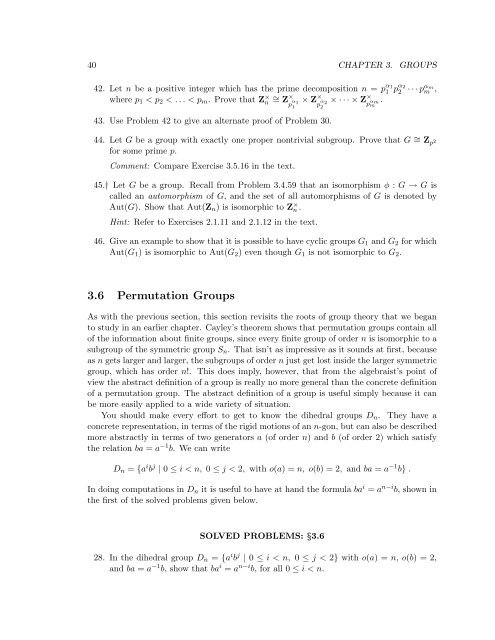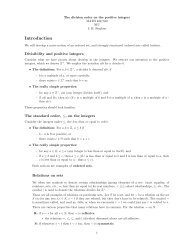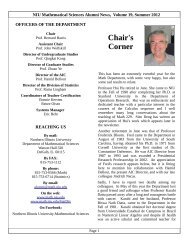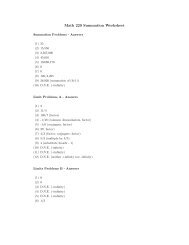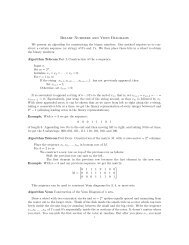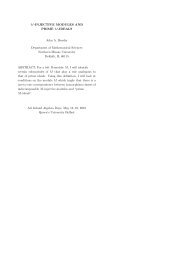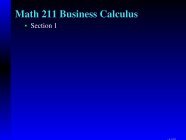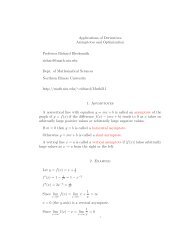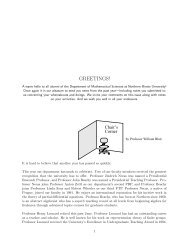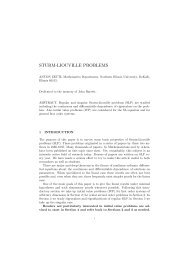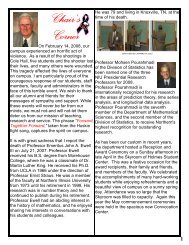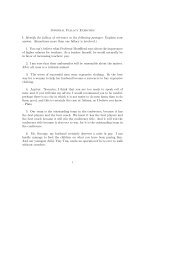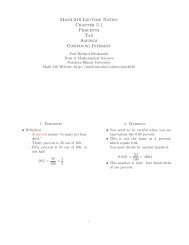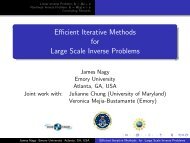abstract algebra: a study guide for beginners - Northern Illinois ...
abstract algebra: a study guide for beginners - Northern Illinois ...
abstract algebra: a study guide for beginners - Northern Illinois ...
Create successful ePaper yourself
Turn your PDF publications into a flip-book with our unique Google optimized e-Paper software.
40 CHAPTER 3. GROUPS<br />
42. Let n be a positive integer which has the prime decomposition n = p α1<br />
where p1 < p2 < . . . < pm. Prove that Z × n ∼ = Z ×<br />
p α 1<br />
1<br />
× Z ×<br />
p α 2<br />
2<br />
43. Use Problem 42 to give an alternate proof of Problem 30.<br />
× · · · × Z ×<br />
p αm<br />
m .<br />
1 pα2 2<br />
· · · pαm<br />
m ,<br />
44. Let G be a group with exactly one proper nontrivial subgroup. Prove that G ∼ = Z p 2<br />
<strong>for</strong> some prime p.<br />
Comment: Compare Exercise 3.5.16 in the text.<br />
45.† Let G be a group. Recall from Problem 3.4.59 that an isomorphism φ : G → G is<br />
called an automorphism of G, and the set of all automorphisms of G is denoted by<br />
Aut(G). Show that Aut(Zn) is isomorphic to Z × n .<br />
Hint: Refer to Exercises 2.1.11 and 2.1.12 in the text.<br />
46. Give an example to show that it is possible to have cyclic groups G1 and G2 <strong>for</strong> which<br />
Aut(G1) is isomorphic to Aut(G2) even though G1 is not isomorphic to G2.<br />
3.6 Permutation Groups<br />
As with the previous section, this section revisits the roots of group theory that we began<br />
to <strong>study</strong> in an earlier chapter. Cayley’s theorem shows that permutation groups contain all<br />
of the in<strong>for</strong>mation about finite groups, since every finite group of order n is isomorphic to a<br />
subgroup of the symmetric group Sn. That isn’t as impressive as it sounds at first, because<br />
as n gets larger and larger, the subgroups of order n just get lost inside the larger symmetric<br />
group, which has order n!. This does imply, however, that from the <strong>algebra</strong>ist’s point of<br />
view the <strong>abstract</strong> definition of a group is really no more general than the concrete definition<br />
of a permutation group. The <strong>abstract</strong> definition of a group is useful simply because it can<br />
be more easily applied to a wide variety of situation.<br />
You should make every ef<strong>for</strong>t to get to know the dihedral groups Dn. They have a<br />
concrete representation, in terms of the rigid motions of an n-gon, but can also be described<br />
more <strong>abstract</strong>ly in terms of two generators a (of order n) and b (of order 2) which satisfy<br />
the relation ba = a −1 b. We can write<br />
Dn = {a i b j | 0 ≤ i < n, 0 ≤ j < 2, with o(a) = n, o(b) = 2, and ba = a −1 b} .<br />
In doing computations in Dn it is useful to have at hand the <strong>for</strong>mula ba i = a n−i b, shown in<br />
the first of the solved problems given below.<br />
SOLVED PROBLEMS: §3.6<br />
28. In the dihedral group Dn = {a i b j | 0 ≤ i < n, 0 ≤ j < 2} with o(a) = n, o(b) = 2,<br />
and ba = a −1 b, show that ba i = a n−i b, <strong>for</strong> all 0 ≤ i < n.


